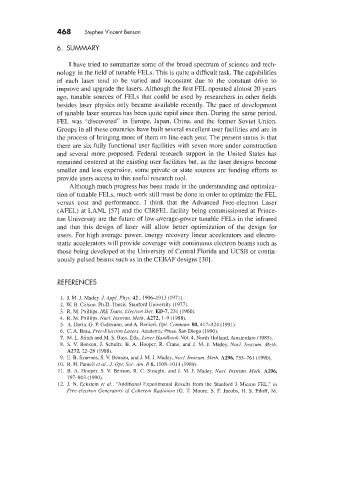Page 508 - Tunable Lasers Handbook
P. 508
468 Stephen Vincent Benson
6. SUMMARY
I have tried to summarize some of the broad spectrum of science and tech-
nology in the field of tunable FELs. This is quite a difficult task. The capabilities
of each laser tend to be varied and inconstant due to the constant drive to
improve and upgrade the lasers. Although the first FEL operated almost 20 years
ago. tunable sources of FELs that could be used by researchers in other fields
besides laser physics only became available recently. The pace of development
of tunable laser sources has been quite rapid since then. During the same period,
FEL was "discovered'' in Europe, Japan, China, and the former Soviet Union.
Groups in all these countries have built several excellent user facilities and are in
the process of bringing more of them on line each year. The present status is that
there are six fully functional user facilities with seven more under construction
and several more proposed. Federal research support in the United States has
remained centered at the existing user facilities but, as the laser designs become
smaller and less expensive, some private or state sources are funding efforts to
provide users access to this useful research tool.
Although much progress has been made in the understanding and optimiza-
tion of tunable FELs, much work still must be done in order to optimize the FEL
versus cost and performance. I think that the Advanced Free-electron Laser
(AFEL) at LANL [57] and the CIRFEL facility being commissioned at Prince-
ton University are the future of low-average-power tunable FELs in the infrared
and that this design of laser will allow better optimization of the design for
users. For high average power, energy recovery linear accelerators and electro-
static accelerators will provide coverage with continuous electron beams such as
those being developed at the University of Central Florida and UCSB or contin-
uously pulsed beams such as in the CEBAF designs [30].
REFERENCES
1. J. Rl. J. hladey.J.App1. Pliys. 42, 1906-1913 (1971).
2. W. B. Colson. Ph.D. Thesis. Stanford University (1977).
3. R. RI. Phillips. IRE Trans. Elecrron Dei.. ED-7, 231 (1960).
4. R. hl. Phillips, Niic/. Iiistnini. Merh. 4272, 1-9 (1988).
5. -4. Doria. G. P. Gallerano, and.& Renieri. Opt. Coinnzun. 80,417424 (1991).
6. C. A. Brau, Free-Electron Lasers. Academic Press. San Diego (1990).
7. M. L. Stitch and M. S. Bass, Eds.. Laser Handbook. Vol. 4. North Holland, Amsterdam (1985).
8. S. V. Benson, J. Schultz. B. A. Hooper. R. Crane, and J. h,f. J. Madey, Nud. Iimruni. Metl7,
4272.12-28 (1988).
9. E. B. Szarmes, S. V. Benson, and J. h.1. J. h,fadey, Nucl. Insfrum. .kleth, A296,755-761 (1990).
10. R. H. Pantell et al.. J. Opt. Soc. Ani. B 6, 1008-1014 (1989).
11. E. A. Hooper, S. V. Benson, R. C. Straight. and J. M. J. Madey, Nz{c/. Insrrunz. Metlz. 4296,
797-803 (1990).
12. J. N. Eckstein et al., 'Xdditional Experimental Results from the Stanford i Micron FEL." in
Free-electron Generators of Coherent Radiation (G. T. Moore. S. E Jacobs. H. S. Piloff, M.

